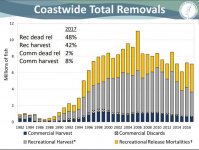Mike wrote:
Marq,
C&R striped bass delayed mortality is estimated to be 9 percent on average, not 49 percent. The nine percent figure likely comes from an average of delayed mortality studies and I would expect that they used the ones that were conducted under various temperature and salinity conditions and maybe various baits/terminal tackle. Fish are caught by hook and line and then placed in net pens in the same water body to monitor mortality over a period of time that typically lasts for a few days.
Poopdeck,
The Delaware Estuary slot limit, supported by substantial data analysis, was developed by the state of Delaware. Based on years of my failed attempts to get the other basin states to agree to the concept of a designated official Pa C&R spring season, Delaware asked if Pa wished to participate in a slot instead. When we reviewed the biological and fish behavioral logic behind the slot, my staff and I developed a proposal for when (months) the slot should be applied in Pa. We also reviewed scientific info and law enforcement experiences regarding circle hooks. Ultimately, we did not propose a circle hook requirement and our agency approved the proposal, as did the ASMFC striped bass technical committee and ASMFC striped bass Board. Delaware applies its slot in summer when the fish are residing in the Bay; Pa applies its slot in spring when the fish are temporarily ( for the most part) in Pa. it is an example of cooperation and coordination between states in managing a fishery.
NJ does not have a striper fishing season on the spawning grounds; they have a spring ocean fishery in which their anglers can participate, which is why harvest is only allowed from the Pa side of roughly mid-channel. Combined with Pa’s reg, including what has been a gradually narrowing slot and a two fish creel limit focusing on male stripers, harvest is only allowed on one side of the Estuary. As most of the better concentrations of stripers occur on the NJ side, the legal take from the spawning grounds is limited.





